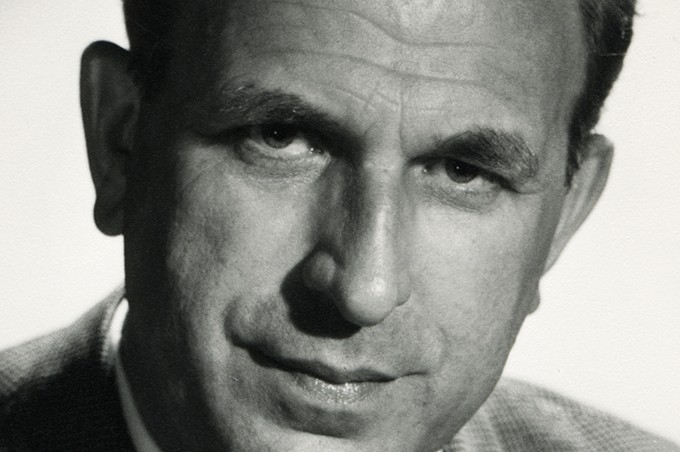25 May 2023
P.R. Jenkins
Spotlight Shostakovich: the tenth symphony

“I always envisioned performing this piece as he had perhaps dreamed or perhaps not even dared to dream. And it was all very moving when he finally came onto the podium; I could feel that he was trembling with excitement. He is a very she man, someone who doesn’t say very much. But I could sense that he was hugely satisfied.”
Karajan about Shostakovich’s 10th in Moscow
Dmitri Shostakovich (1906 – 1975) and Karajan were about the same age. Karajan admired Shostakovich and he even admitted that if he had become a composer instead of a conductor, his music would have sounded like Shostakovich’s.
Although Karajan studied several symphonies by Shostakovich (for example the 5th and the monumental 8th), he only performed and recorded the very personal 10th, the one that Shostakovich started to compose immediately after Stalin’s death in March 1953. Officially, Stalin was “General Secretary of the Communist Party of the Soviet Union”. In fact, he was the all-powerful dictator of the Soviet Union from 1927 until his death. Shostakovich, as a prominent artist in the Soviet Union, lived in constant fear of being arrested and executed by Stalin’s henchmen. The second movement, a short furious Scherzo, is often regarded as a “musical portrait” of Stalin in which Shostakovich imitates the characteristic howling sound of the “Katyusha” rocket launcher, also known as “Stalin’s organ”. Whether this is true or not, it is certainly one the most terrifying and powerful movements in 20th century music.
In an interview with Richard Osborne in 1988, Karajan, who is often seen as a recording “machine”, gave an astonishing explanation why he hadn’t conducted more works by Shostakovich. For him, it was simply not necessary.
RO: One thing I have sensed with the great records you have made of 20th-century music — the Berg Three Orchestral Pieces, the Prokofiev Fifth, the Honegger Liturgique, the Shostakovich Tenth — they are works which somehow express the tragedy of our century. You were six years old when the First World War started. Is this something which is in your consciousness, this sense of the tragedy of our times and music’s healing capacity?
HvK: Yes, yes, certainly. I had very good relations with Shostakovich. When I was the last time in Moscow, I played the Tenth Symphony. He was so nervous and at the same time so impressed…he said I can’t speak but…he was a very great composer.
RO: I heard once that you wanted to conduct his Sixth Symphony but you said that Mravinsky had done it so well that you wouldn’t touch it.
HvK: Yes, I did.
RO: You said that?
HvK: Yes.
RO: He was a great conductor.
HvK: I am a great admirer of him. He was the representative of this older generation in perfection.
“The symphony was finished and a man in the sixth row jumped up and shouted ‘Bravo!’. That was Karajan. Shostakovich was saved, and we all knew that it must be good” recalled Barbara Sanderling, the widow of Kurt Sanderling, who conducted the Staatskapelle Dresden’s performance of Shostakovich’s 8th symphony at the Salzburg Festival in 1965. In August 1976, Karajan himself conducted Shostakovich’s 10th with the Staatskapelle. Peter Cossé wrote for the Salzburger Nachrichten: “In recent years, I haven’t seen Karajan so urgent, so dynamically determined to realise his artistic aims. His energy animated the playing and expressivity of the Dresden musicians like some electrifying drug.” Our institute was part of a project which published the live recording of this concert as a cd in 2017.
“They played at two hundred per cent capacity. It was unbelievable.”
Mariss Jansons
Karajan’s first performance of the 10th was in 1959. The most special one was certainly the Moscow concert on May 29th 1969, with Shostakovich himself in the audience. Karajan conducted three concerts with the Berlin Philharmonic (the Shostakovich symphony on the second evening only) and the demand was enormous. Shostakovich remembered: “There was a siege of the concert hall (the Tchaikovsky conservatory), the tickets were sold out for a long time. At the entrance militia with horses (…) Maria Yudina sat on the pavement: ‘I will only get up if someone gives me a ticket.’” Maria Yudina was the pianist who once wrote to Stalin “I will pray to the lord that he forgives your heavy sins against people and nation” – and survived. About the concert Richard Osborne, Karajan’s biographer, wrote: “The orchestra’s commitment was astonishing. Mariss Jansons recalled: ‘They played at two hundred per cent capacity. It was unbelievable.’ Shostakovich joined Karajan and the orchestra on stage afterwards, obviously moved by the performance and the reception he received.”

Altogether, Karajan performed the symphony 20 times in concert and recorded it twice in studio (1966 and 1981, both times with the Berlin Philharmonic).
What else happened in Moscow? Wolfgang Stresemann, manager of the Berlin Philharmonic, later recalled his impressions of the concert the day before in the Moscow Conservatory: “At the beginning of an all-Beethoven programme was the ‘Coriolan’ overture; then the ‘Pastorale’ – but only a few bars. A door on the balcony was pushed open noisily and Karajan stopped. What had happened? Some young people, music students apparently, who weren’t allowed into the concert had entered by force to attend the concert at least standing. Even for Soviet guards it was impossible to throw them out, so they were admonished to be quiet and the ‘Pastorale’ began again.”
We’ve prepared a playlist with Karajan conducting Shostakovich’s tenth symphony. Listen to it here.
— P.R. Jenkins
Richard Osborne: “Karajan. A Life in Music” Chatto & Windus, London. 1998
Gramophone, April 1988
Wolfgang Stresemann: “Ein seltsamer Mann. Erinnerungen an Herbert von Karajan.” List Taschenbuch 2008


